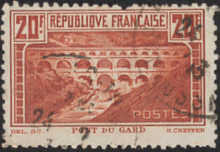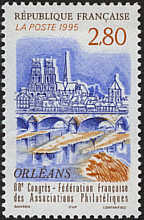|
In its first definition, a bridge is a structure intended to allow
communication by connecting two points separated by an obstacle. From
the first wooden or stone bridges and the primitive footbridges made of
lianas, to the latest technological marvels of the end of the 20th
century, a large variety of materials has been used in order to achieve solidity,
efficacy, practicality, rapidity and cost efficiency. Stone, iron, steel
and concrete have been used in increasingly sophisticated architectural
structures. Built initially to satisfy commercial, strategic and economic
needs, bridges have also been designed for tourist purposes and sometimes
even for aestheticism. Often destroyed, rebuilt, re-destroyed, and rebuilt
again... bridges have marked history and human relations, becoming a
privileged subject for representation in the history of Art, providing
themes for many stories, films, novels, and even songs.
They have also been the centerpiece of many architectural competitions. It
is as difficult to classify the representations of bridges in philately as
it is to categorize the bridges themselves. Whether it be by their form,
the nature of the materials used or even by their function, such as a
highway-bridge, footbridge, viaduct, aqueduct… the exceptions are always
numerous and make any attempt at classification even more difficult. HTML
page-setting and the addition of increasingly sophisticated architectural
structures. Built initially to satisfy commercial, strategic and economic
needs, bridges have also been designed for tourist purposes and sometimes
even for aestheticism. Often destroyed, rebuilt, re-destroyed, and rebuilt
again... bridges have marked history and human relations, becoming a
privileged subject for representation in the history of Art, providing
themes for many stories, films, novels, and even songs.
They have also been the centerpiece of many architectural competitions. It
is as difficult to classify the representations of bridges in philately as
it is to categorize the bridges themselves. Whether it be by their form,
the nature of the materials used or even by their function, such as a
highway-bridge, footbridge, viaduct, aqueduct… the exceptions are always
numerous and make any attempt at classification even more difficult. HTML
page-setting and the addition of
 links
permit an instantaneous simplification of the tiresome references and
endnotes in printed documents, although without ever completely replacing
the latter. A bridge can be the only theme of a stamp - or a series of
stamps - issued on a purely commemorative basis to highlight its technical
and architectural qualities. It can also simply be an element of the
landscape represented, urban or rural. In other cases, it plays the
symbolic role that it fulfilled throughout the eventful history of
mankind, a symbol associated with a city, an event, or even a character.
More rarely, its aesthetic qualities or its use for artistic and
expressive ends are highlighted. Following the completion of a European educational project
carried out within the framework of my job –- I was a high school Art links
permit an instantaneous simplification of the tiresome references and
endnotes in printed documents, although without ever completely replacing
the latter. A bridge can be the only theme of a stamp - or a series of
stamps - issued on a purely commemorative basis to highlight its technical
and architectural qualities. It can also simply be an element of the
landscape represented, urban or rural. In other cases, it plays the
symbolic role that it fulfilled throughout the eventful history of
mankind, a symbol associated with a city, an event, or even a character.
More rarely, its aesthetic qualities or its use for artistic and
expressive ends are highlighted. Following the completion of a European educational project
carried out within the framework of my job –- I was a high school Art
 teacher
near Orleans , now retired –I
became interested in this topic and I started to collect
all the stamps and documents represented here. I then tried,
by way of this website, which grows each week, to make a small anthology
of these buildings through their representations in philately, a field
symbolic of the cultural and universal "bridges" that try to connect and
unite people. This site is not an exhaustive encyclopedia, but rather
through the pictures, a
bridge towards knowledge, curiosity and culture… teacher
near Orleans , now retired –I
became interested in this topic and I started to collect
all the stamps and documents represented here. I then tried,
by way of this website, which grows each week, to make a small anthology
of these buildings through their representations in philately, a field
symbolic of the cultural and universal "bridges" that try to connect and
unite people. This site is not an exhaustive encyclopedia, but rather
through the pictures, a
bridge towards knowledge, curiosity and culture…
Michel Wagner June 2004/2018
1Click on the pictures, in order to access to the
correspondent chapter.
|
Best resolution: 1024 x 768 |

Men are building too many walls, not enough bridges
..." Isaac Newton.
Postcard, photo : W. Cohnen. Editions Frazer SA- CH" |
|
 All the documents, stamps, photos and letters reproduced in these pages,
when they are not in inverted commas( feature articles)... are from my
personal collection; Any use or reproduction, even partial, requires my
authorization ... Michel Wagner
All the documents, stamps, photos and letters reproduced in these pages,
when they are not in inverted commas( feature articles)... are from my
personal collection; Any use or reproduction, even partial, requires my
authorization ... Michel Wagner
All The documents,
stamps, photos, letters
reproduced in these pages, apart from
those whose origin
is mentioned ...
are an integral part of my
personal collection.
"All Rights Reserved for
rights holders
unidentified"
©
2004-2016
"Les ponts et leurs
représentations en philatélie." |